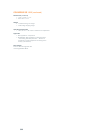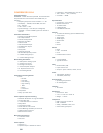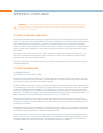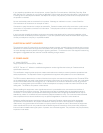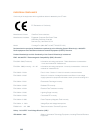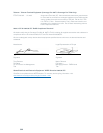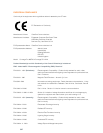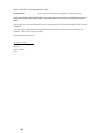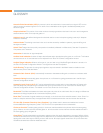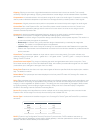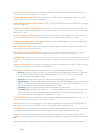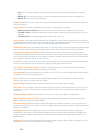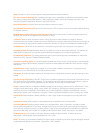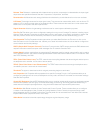312
Dial Tone Level A setting in the Channel Property Configuration window for Telco Rx channels that allows you to
adjust the dial tone level in 1dB steps to ±12dB.
DNS (Domain Name System) Part of the IP protocol suite, DNS manages the translation of plain-text internet
domain names (URLs) into numeric IP addresses.
DTMF (Dual Tone Multi Frequency) Dialing DTMF or touch-tone dialing allows users to issue tones for access to
voice mail, pagers, etc.
DTMF (Dual Tone Multi Frequency) Level A setting in the Channel Property Configuration window for Telco Rx
channels used to adjust the level (volume) of the DTMF tones that are heard when dialing. Level can be adjusted in
1dB steps to ±12dB.
EC (Echo Canceller) Reference A signal that contains an electronic copy of all signals which will be removed
from the signal the mics pick up. This is always the far-end audio and, optionally, local audio sources.
EC (Echo Canceller) Reference Summing The ability to combine multiple signals in a single echo cancellation
reference signal. See also Virtual Reference.
ERL (Echo Return Loss) The ERL meter shows the coupling between the reference signal and the input to the
echo canceller—the ratio of the two levels.
ERLE (Echo Return Loss Enhancement) The echo return loss enhancement (ERLE) meter shows the loss
through the echo cancellation and NLP (non-linear processing) chain—the ratio of the two levels.
Expansion Bus Consists of two RJ-45 connectors (the Link In and Link Out ports) on the rear panel of all Converge
Pro models. The Expansion Bus allows multiple Converge Pro devices to be linked together using CAT-5 twisted-pair
cable.
Expansion Bus Reference The Expansion Bus Reference allows you to reference an output on another Converge
Pro device in a site for Echo Cancellation and PA Adaption.
Filter A device that passes and blocks audio signals based on user-definable requirements of the system.
All Pass• A filter that provides only phase shift or phase delay without appreciably changing the magnitude
characteristic. The filter produces a flat amplitude response. It is useful for matching the delay of two
processing channels with different delays.
High Pass• A filter that passes high signal frequencies while attenuating low frequencies.
High Shelving• Provides boosting or attenuation of frequencies above a designated frequency. The transition
between the spectrum above and below the designated frequency occurs at a fixed 6dB/octave rate. The
gain or loss above the corner frequency is adjustable to +/- 15dB.
Low Pass• A filter that passes low frequencies while attenuating high frequencies.
Low Shelving• Provides boosting or attenuation of frequencies below a designated frequency. The transition
between the spectrum above and below the designated frequency occurs at a fixed 6dB/octave rate. The
gain or loss below the corner frequency is adjustable to +/- 15dB.
First Mic Priority Increases the audio level required to gate on additional microphones after the first mic is on. This
helps ensure that only one mic gates on when a person speaks.
Gain The amount a signal is increased over a given reference, typically 0, normally specified in dB (decibels). On
Converge Pro devices, gain is adjustable from -65 to 20dB (85dB range) in .5dB increments.
Gain Structure A set of configuration parameters that define the gain characteristics of a signal. The optimal input
gain setting is one which provides both an adequate signal-to-noise ratio and reasonable headroom.
Gateway A device used to provide external network access to client devices on IP networks. All traffic with IP
addresses outside the specified subnet mask are automatically routed to the gateway. See also DHCP and Subnet
Mask.
Gating The activation and deactivation of mic inputs. Converge Pro provides three types of microphone gating:



